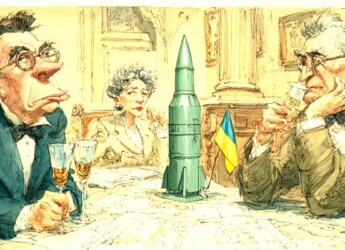|
|
Content Assessment: The Fog of Censorship: Self-Censorship and Legal Limits Roil the Russo-Ukrainian Information Space (September 25 - October 1, 2023)
Information
Insight
Relevance
Objectivity
Authority
Excellent
A short assessment of the qualitative benefit of the recent update on the Russo-Ukrainian War prepared by ComplexDiscovery from reporting and maps from Institute of the Study of War.
Editor’s Note: This report provides a comprehensive overview of developments in the Russo-Ukrainian War from September 25 to October 1, 2023, as documented by the Institute for the Study of War. Key takeaways include marginal Ukrainian gains around Bakhmut and western Zaporizhia despite continued Russian assaults along multiple axes; uncertainty around the status of Russia’s Black Sea Fleet leadership after Ukrainian strike claims; persistent tensions from ethnic minorities within Russian units; Russia’s ongoing military reforms and recruiting efforts to offset losses; increased Kremlin legal crackdowns and military blogger self-censorship; and continued Russian strikes on Ukrainian infrastructure amid slow attrition on the frontlines. The report suggests Russia has failed to gain substantial ground as Ukraine’s counteroffensive exerts pressure, even as Russia adapts its forces and information space to the realities of the drawn-out war.
The Institute’s reports also highlight increased restrictions and self-censorship shaping the information space on both the Russian and Ukrainian sides of the war.
In Russia, the Kremlin advanced legal crackdowns to restrict online dissent, such as a new law criminalizing the promotion of extremism. Prominent Russian military bloggers also claimed to heavily self-censor their content to avoid backlash when reporting unfavorable battlefield realities. This self-censorship manifests in milbloggers avoiding detailed discussion of tactical setbacks or Russian losses.
On the Ukrainian side, the reports suggest the Ukrainian government and military officials carefully managed the flow of information regarding high-profile claims, such as the alleged killing of Russia’s Black Sea Fleet commander. The reports note Ukrainian authorities did not rush to confirm or deny their own initial claims once Russia put forth contrary information.
Overall, the Institute’s reports illustrate how both Russia and Ukraine are increasingly shaping the information space to control narratives, limit dissent, and keep their adversary off balance – signifying a key domain of contestation beyond the physical battlefield. The rampant self-censorship highlights the increasing opacity of assessing the war’s realities through open online sources.
Source Note: One of the most accurate and detailed sources for ongoing updates on the Ukraine crisis is the Russian Offensive Campaign Assessment from the Institute for the Study of War. The Institute for the Study of War (ISW) is a 501(c)(3) organization and produces strictly non-partisan, non-ideological, fact-based research. ISW seeks to promote an informed understanding of war and military affairs through comprehensive, independent, and accessible open-source research and analysis. ISW’s research is made available to the general public, military practitioners, policymakers, and media members. Providing a daily synthesis of key events related to the Russian aggression against Ukraine, ISW updates may benefit investigators and litigators as they follow the business, information technology, and legal trends and trajectories impacted by and stemming from the current Russo-Ukrainian conflict.
For those seeking to grasp the full scope of this evolving landscape, the complete updates from the Institute for the Study of War serve as an invaluable resource.
Assessments and Maps*
Russo-Ukrainian Conflict Assessments
- Institute for the Study of War (ISW), Russia Team
- Critical Threats Project (CTP), American Enterprise Institute
General Assessment Background Info
- ISW systematically publishes Russian campaign assessments, including maps highlighting the assessed control of terrain in Ukraine and main Russian maneuver axes.
- Maps augment daily synthetic products that cover key events related to the Russian aggression against Ukraine.
The Russian Offensive Campaign Assessments
Overall Summary
The Institute for the Study of War provided key insights into developments in the ongoing Russo-Ukrainian War from September 25 to October 1, 2023.
On October 1, the Institute reported that Russian forces conducted tactical counterattacks in the Robotyne area as part of their elastic defense against Ukrainian offensive operations in western Zaporizhia Oblast. The situation south of Robotyne remained fluid as some tactically significant field fortifications changed hands several times.
The Russian information space continued to falsely portray Western aid to Ukraine as escalatory, likely to discourage continued Western support for Ukraine. The status of the Wagner Group remained unclear amid reported negotiations about the group’s future cooperation with the Russian government. Russian forces conducted another series of drone strikes against Ukraine overnight.
On September 30, the Institute reported that Ukrainian forces continued counteroffensive operations in western Zaporizhia Oblast and near Bakhmut. The Kremlin had not yet clarified what Ukrainian territories it claimed Russia annexed, leading to confusion among Russian government and occupation officials. Russian forces conducted a series of drone strikes primarily targeting Vinnytsia Oblast overnight. Russian milbloggers claimed the Russian military removed the commander of the 205th Motorized Rifle Brigade following outrage over the brigade’s leadership. An organization tied to a senior Russian official was reportedly categorizing Russian internet user data to disseminate tailored narratives and control the information space. Russian forces conducted localized offensive operations but did not make significant gains.
On September 29, Ukrainian forces made marginal gains near Bakhmut and western Zaporizhia Oblast. Prominent Russian milbloggers had become less inclined to report tactical realities, while fringe sources speculated about senior military leadership. The Russian government announced details of the October conscription cycle, including in annexed Ukrainian territories. Russian President Vladimir Putin signaled support for the Defense Ministry’s effort to recruit Wagner Group fighters, as the National Guard’s negotiations reportedly stalled. The Russian parliament advanced a bill to expand surveillance of internet and telecom users. Russian forces conducted offensives but did not make substantial advances.
On September 28, Ukrainian forces continued operations near Bakhmut and western Zaporizhia Oblast as the tactical situation in Verbove remained unclear. The tempo of Russian offensives along the Kupyansk-Svatove-Kreminna line decreased in recent days. Russian aviation increased strikes around Kharkiv, Luhansk and Kherson but was less active in western Zaporizhia. Russian milbloggers claimed to heavily self-censor their reporting. The Duma moved to criminalize extremism, likely encouraging self-censorship. Russian forces counterattacked in several areas but did not gain ground.
On September 27, Ukrainian forces marginally advanced near Bakhmut and western Zaporizhia Oblast. The situation around Verbove was increasingly unclear as prominent Russian milbloggers avoided detailed reporting. Russian media published inconclusive “proof” that the Black Sea Fleet commander was alive after Ukrainian claims to have killed him. The piecemeal return of some Wagner Group fighters to Ukraine indicated struggled attempts to reform the group. Russian forces continued assaults along several axes but did not advance their positions.
On September 26, the tactical situation in Verbove remained uncertain amid Ukrainian operations in western Zaporizhia. Likely degraded Russian 58th Army elements increased counterattacks around Novoprokopivka, suggesting elite Russian airborne units had been weakened there. Russian defenses in depth seemed undermanned as some 58th Army units were identified near Tokmak. Interethnic tensions appeared to divide elements of Russia’s 42nd Motorized Rifle Division. Russia’s Defense Minister discussed efforts to transform airborne units into a role more akin to motorized rifle units. Overnight strikes targeted Ukrainian ports and military sites. Russian media claimed the Black Sea Fleet commander was alive after Ukraine said he was killed. The Defense Ministry reportedly recruited some Wagner fighters as negotiations with the National Guard stalled. Russian forces counterattacked in several areas.
On September 25, the Institute reported that the tactical situation in Verbove remained unclear amid continued Ukrainian offensive operations in western Zaporizhia Oblast. The Ukrainian Special Operations Forces claimed a Ukrainian strike on September 22 in occupied Sevastopol killed 34 Russian officers, including Black Sea Fleet Commander Admiral Viktor Sokolov. Ukrainian forces reportedly struck the Khalino Airfield and an FSB building in Kursk Oblast during drone strikes on September 24. Overnight, Russian forces conducted drone and missile strikes on Ukrainian port, grain, and military targets. Ukrainian President Volodymyr Zelensky confirmed that US-provided Abrams tanks arrived in Ukraine. Russian military officials continued efforts to build forces suited for the war in Ukraine. The Kremlin and Armenian government continued to deflect blame for the surrender of Nagorno-Karabakh as Armenian-Russian relations deteriorated. Russian forces continued unsuccessful offensives near Bakhmut, along the Avdiivka-Donetsk City line, and in western Zaporizhia Oblast.
In summary, throughout the past week Russian forces maintained ground assaults along several axes in eastern and southern Ukraine but failed to gain substantial ground. Ukraine’s counteroffensive saw marginal gains around Bakhmut and western Zaporizhia Oblast as Russia struggled to bring reserve forces to bear. The status of Russia’s Black Sea Fleet leadership remained uncertain amid conflicting claims. Tensions persisted around ethnic minorities within Russian units in southern Ukraine. Russia continued forming new military units and recruiting contract servicemen to offset losses, while seeking to bring Wagner Group elements under state control. The Kremlin pushed legal measures to curb online dissent as military bloggers increasingly self-censored. Russia maintained strikes on Ukrainian infrastructure even as its forces faced slow attrition on the front lines.
We do not report in detail on Russian war crimes because those activities are well-covered in Western media and do not directly affect the military operations we are assessing and forecasting. We will continue to evaluate and report on the effects of these criminal activities on the Ukrainian military and population and specifically on combat in Ukrainian urban areas. We utterly condemn these Russian violations of the laws of armed conflict, Geneva Conventions, and humanity even though we do not describe them in these reports.
Detailed Reporting with Maps for September 25 – October 1, 2023, from the ISW – Mouseover to Scroll
Russian Offensive Campaign Assessment – September 25 – October 1, 2023Review the Detailed Reporting and Maps PDF
See the Institute for the Study of War Interactive Map of the Russian Invasion
Read the latest Ukraine Conflict updates from the Institute for the Study of War
* Shared with direct express permission from the Institute for the Study of War (ISW).
About the Institute for the Study of War Research Methodology
ISW’s research methodology relies on both primary and secondary sources, enabling researchers to develop a comprehensive understanding of the situation on the ground. In order to analyze military and political developments in any given area, ISW’s research analysts must wholly understand the systems of enemy and friendly forces. They must also understand the population demographics, physical terrain, politics, and history of that area. This lays the analytical foundation for understanding the reasons for particular developments and fulfilling their assigned research objectives. ISW analysts also spend time in places like Iraq, Afghanistan, and elsewhere in order to gain a better understanding of the security and political situation and to evaluate the implementation of current strategies and policies. Our researchers compile data and analyze trends, producing a granular analysis of developments in areas of research, producing an accurate, high-resolution, timely, and thorough picture of the situation. ISW’s research methodology guarantees its success and commitment to improving the nation’s ability to execute military operations, achieve strategic objectives, and respond to emerging problems that may require the use of American military power.
About the Institute for the Study of War
The Institute for the Study of War advances an informed understanding of military affairs through reliable research, trusted analysis, and innovative education. We are committed to improving the nation’s ability to execute military operations and respond to emerging threats in order to achieve U.S. strategic objectives. ISW is a non-partisan, non-profit, public policy research organization.
Learn more, get involved, and contribute today.
Additional Reading
- From Dissent to OSINT? Understanding, Influencing, and Protecting Roles, Reputation, and Revenue
- [Annual Update] International Cyber Law in Practice: Interactive Toolkit
- Data Embassies: Sovereignty, Security, and Continuity for Nation-States
Assisted by GAI and LLM Technologies
Source: ComplexDiscovery








































